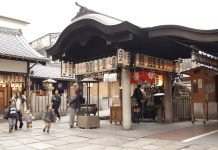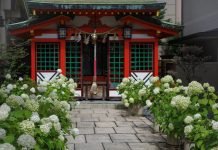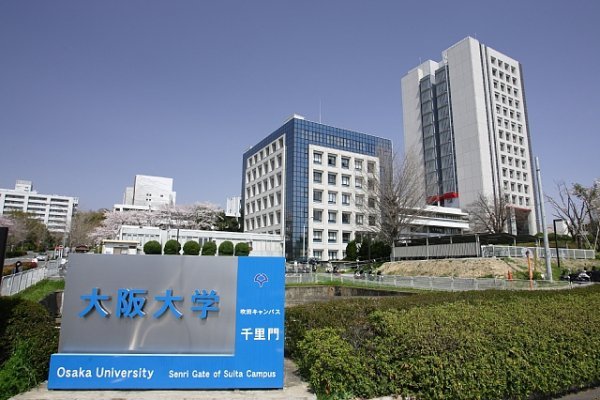
Osaka University is one of the nine imperial universities that existed before the outbreak of World War II. Of these nine universities, seven were in Japan and two were in Korea and Taiwan. After the end of the war, the seven imperial universities in Japan were all transformed into national universities (総合大学). Although they have been gradually forgotten by modern people, these seven imperial universities can be said to have been a major research center during the Pacific War. Among them, Osaka University has preserved many research documents from the war. In this article, you will be able to understand the unknown connection between Osaka University and the war, exploring the history of Japan and the development of Osaka University in its context. Some of my perspectives of being a foreign student will be included, and you are welcome to think about how you see the evolution of Osaka University.
Table of Contents
The origin of The Faculty of Science and The Faculty of Engineering

According to the official website of Osaka University, the University’s predecessor was established in 1838 as “Tekijuku” (適塾). It was a private school in the Edo period, and its curriculum was mainly focused on medicine. Some of the famous students included Fukuzawa Yukichi (福澤諭吉), Ootori Keisuke (大鳥圭介) and Hashimoto Sanai (橋本佐内). Who is Fukuzawa Kakichi? It is the person appearing on the 10,000 yen bill replaced by Shibusawa Eiichi after Reiwa (令和). After the Meiji Restoration, Tekijuku was transformed into Osaka College (大阪医学校) and Osaka Prefectural Medical University (大阪府立医科大学), and only in 1931 did it officially become Osaka Imperial University. In addition to the Faculty of Medicine, the Faculty of Science, followed by the Faculty of Engineering, was also established at an early stage, while the Faculty of Arts and Law was not formally established until after the war. Unlike Kyoto University, Osaka University has a very strong engineering focus back then. Because of this, some humorous Osaka University students would joke that only students in the medical, science, and engineering departments are considered pure-blooded Handai (阪大) students.
At the same time, because of its long history, there are many urban legends about Osaka University’s Faculty of Science and Faculty of Engineering. According to legend, there are complete underground tunnels hidden underneath the science and engineering departments of Osaka University. There are many different stories as to why there are underground tunnels. Some say it was an ancient water conservation facility, others say it was used to store radioactive weapons during the war, and others say it was dug as a route to prevent student social movements after the war, so that outside police could enter. Considering the relationship between the Faculty of Science, the Faculty of Engineering, and the War Department of Osaka University, the second theory has been supported by many students. But don’t forget, the above are some of the rumors that have been put together. You can think of these rumors as the cant or neta (ネタ) of Osaka University students, and they can be used as the topics for discussion at izakaya reunions.
Forget urban legends for a moment, you might want to know the real story about the war. I happen to know one.
In 2007, Osaka University absorbed Osaka University of Foreign Studies and established the Department of Foreign Languages. There is an anecdote about Osaka Foreign Language University during the war. When Osaka was attacked by the first Osaka Air Raid in 1945, the faculty members of Osaka University of Foreign Studies fought to the death and closed the library to prevent the books in the collection from being burned by napalms. I have heard many stories like this when I was at the National Taiwan University in Taipei, and some of them have even become urban legends as well. Legend has it that these heroic teachers would take the form of ghosts and haunt the night, telling students to flee to bomb shelters. Unfortunately, I never encountered these war ghosts at either Taiwan University or Osaka University.

The gate the faculty members fought to close up is still there, and you can see it if you visit the campus of Osaka University’s Foreign Language Department. I always have mixed feelings when seeing the remaining gate. Without the gate, the precious documentary record would have been plunged into the fire, which would undoubtedly be a loss to humanity. This door is reminiscent of the tragedy of war. Some people think that the door is a remembrance of the war perpetrators, while others think that it has nothing to do with the war. Personally, I see it as a reminder every time walking past it. Human beings are too forgetful. If we don’t see it with our own eyes, it is easy to forget the damage that war brings to all of humanity. As a Taiwanese, I especially feel this, because after all. Taiwanese were colonized by Japan before the Pacific War and are legally Japanese. However, Taiwanese were not generally regarded as the perpetrators of the war. At the same time, although many Taiwanese fought in the war, the families of those who fought did not consider them to have volunteered to serve their country and sacrificed their lives for it. As a Taiwanese born and raised in Taiwan, it is difficult to describe the emotions I felt when I saw the remnants of the war when I studied in Osaka University. This is what I feel as a Taiwanese after seeing the gate. How about you?
The iron gate of Osaka University Foreign Language University
Address:3-5-10, Senbahigashi, Minoh city, Osaka
Osaka University and Industrial Development
Some people may think that Osaka’s industry developed rapidly because of the war. In fact, before the war, Osaka started to establish industrial schools for economic development. At that time, the technical schools taught a wide range of subjects including mechanics, applied chemistry, ceramics, brewing, mining, shipbuilding, electricity, and textiles. It was because Osaka had an industrial base during the Meiji era that the government was able to use educational institutions to create an ecosystem of war equipment during the war. Although there are many studies surrounding the Pacific War, the war was a gloomy past for Japan, and war studies are still not very welcomed, so that many courses deliberately omit the participation of educational institutions during the war period when describing the development of Osaka’s industry.

Think of it this way. War requires equipment, equipment requires technology, technology requires research and development, and research and development requires human resources. Therefore, industrial education institutions can be said to be the cradle of ready-made talents.
In fact, Osaka Imperial University became the center of various industrial education institutions in Osaka. Hidetsuji Yagi (八木秀次), who was the Director of Science at Osaka Teikoku University, was also a member of the so-called “Committee for the Utilization of Land and Naval Technology (陸海軍技術運用委員会)”.
In 1942 and 1943, a group of researchers from various fields, including private companies, universities, and official research institutions, was assembled in Japan to form the so-called “Research Tonarigumi (隣組),” in which 30 people from Osaka University participated.
I mentioned the Osaka air raid in the previous chapter. Osaka University was not spared from the Great Osaka Air Raid. For example, the Faculty of Engineering lost its buildings and shipyard. This also gave rise to limericks. It is said that the credits from Kyoto University fell from the sky, the credits from Kobe University fell on the road, and the credits from Osaka University sank to the bottom of Osaka Bay. This limerick is mainly about the difficulty of obtaining course credits at Osaka University. However, it is also reminiscent of the fact that Osaka University, as a major war research center, did lose many artillery and shipbuilding factories during the Osaka air raid.
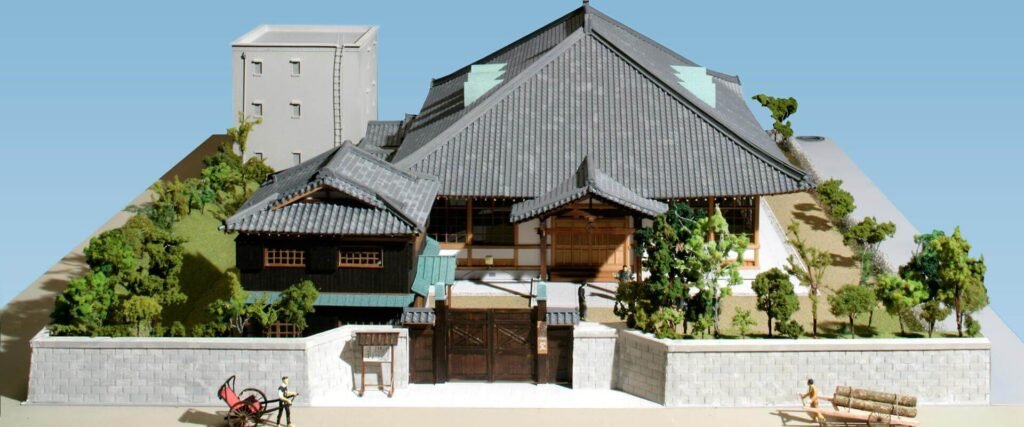
Also, one of the buildings related to Osaka University was also damaged during the Osaka Air Raid. The name of that building was Kaitokudo, which was built in 1724 during the Edo period and was once a major center of academic development in Osaka. The building was donated to the Faculty of Letters of Osaka University, which was established after the war, and many commemorative lectures were given in cooperation with Osaka University. The official website of Kaitokudo currently states that Kaitokudo will carry on the spirit of respecting ethics as well as morality, emphasizing freedom and originality. Isn’t this interesting? The contrast between the Faculty of Engineering, which was under the command of the military during the war, and the Faculty of Letters, which emphasized freedom and independence after the end of the war, is an interesting contrast that highlights the transformation process of Osaka University. The 1/50th model of the restored Kaitokudo can be seen in the main entrance of the Faculty of Letters at Osaka University. The symbolic meaning of the building is self-explanatory. Kaitokudo, which was burned down during the Osaka Air Raid, is now a modern building located a seven-minute walk from Osaka Subway Tanimachi Yonchōme Station.
The 1/50th model of the restored Kaitokudo
Address:1-5 Machikaneyama-cho Toyonaka Osaka
Handaisei (The Student of Osaka University) Tezuka Osamu
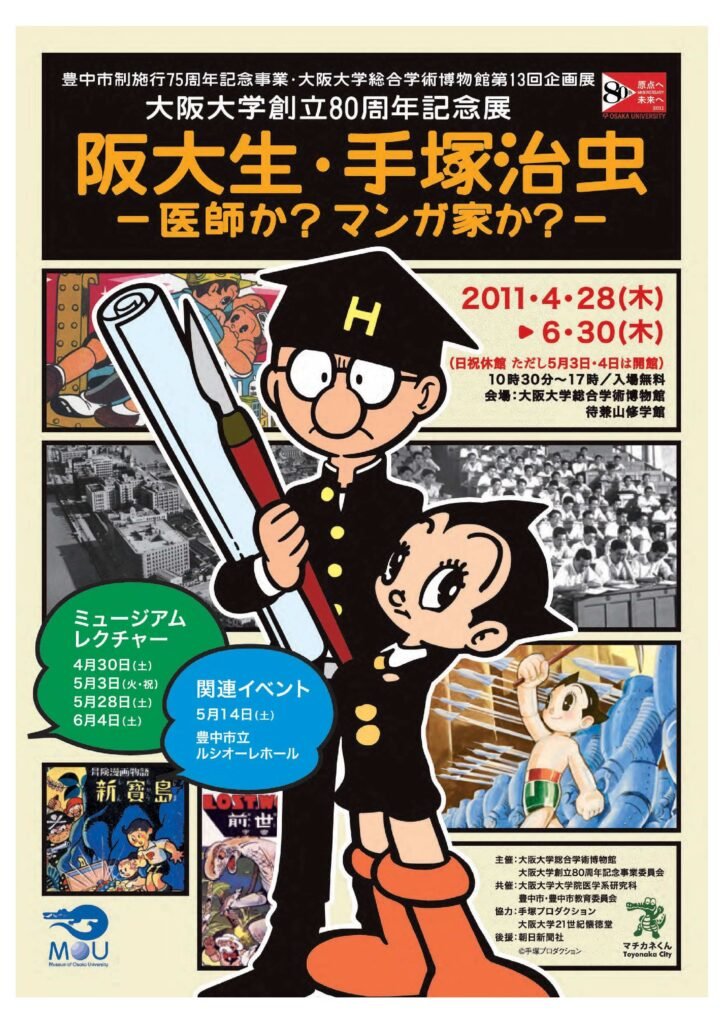
In 2011, the 80th anniversary of the founding of Osaka University, a commemorative exhibition was held. The theme of the exhibition was “Handaisei Tezuka Osamu”. The subtitle was “A Doctor or a Comic Artist”. Tezuka Osamu was a student at Osaka University and entered the medical school of Osaka University in 1945, and made his debut as a manga artist the following year. He graduated in 1951 and obtained his national qualification as a doctor. Have you read any of Tezuka Osamu’s works? I have read a lot of them since I was a child, and although I have forgotten most of the stories, the sad aftertaste still exists today. Many people describe Tezuka Osamu as an anti-war manga artist because he portrayed the tragedy of war to human beings in a straightforward manner through his manga. Many of these comics also depict the Osaka air raid. Tezuka Osamu himself has also been interviewed by NHK, which clearly describes his experience of the raid.
“Suddenly, a formation of B-29s darted in from the clouds, and I was holding my head in my hands, thinking, “I’m screwed, I’m going to die here. The next thing I knew, I was surrounded by holes, and incendiary bombs were flying through me. I ran as hard as I could toward the embankment by the Yodo River. There were human limbs and necks scattered all over the place, burnt to a crisp. I felt like I was dreaming. I felt that I was in another dimension than the air raid, that I was somewhere in the universe, and that this was a lie. It was such a terrible sight.”
According to Tezuka Osamu’s autobiography, he was a doctor by profession and a comic artist as a simple side business. To him, comics may be a kind of documentary tool. Nevertheless, through his comics, he broke through Japan’s post-war publication restrictions and saved many people who were previously afraid to talk about the war. Through his work, many people became willing to talk about the Pacific War and establish the positions of various organizations. In the past, Osaka University would have kept the war materials hidden due to government restrictions. Thanks to Tezuka Osamu’s manga, many people began to want to learn more about the war. Those who wanted to study the war naturally wanted to obtain more information about the time. Those who want to obtain information will naturally experience more of the brutality of war in the process of searching. In this way, the memory of the war will not be forgotten forever. Ignorance gives rise to violence. My personal interpretation of Tezuka Osamu’s work is that the more people understand war, the more they will want to prevent it. To sum up, the importance of peace is better understood through the artifacts, materials and works that have survived the war.





















